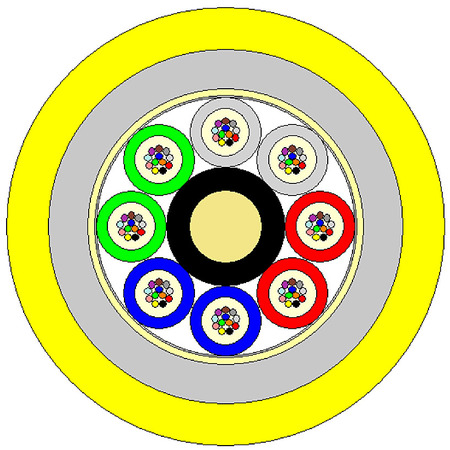Product Details
Prysmian
60023319
TP023407
FPDA|LT|K0T2M1|32 4x8SM CDS-0759
New
Similar Products
Product Description
The 32FO (4x8) Riser Loose Tube Fiber Optic Cable SM G.657.A1 Rodent Protection (Part number: 60023319) from Prysmian with 32FO and Anti Rodent construction . Riser fiber optic cable is used in indoor and outdoor optical networks, more specifically in LAN backbone, access and riser zone. Riser cables are being used more and more in big projects outdoor that's why this type of cable benefits from a special jacket for different necessities.
The 32FO (4x8) Riser Fiber Optic Cable G.657.A1 Rodent Protection from Prysmian is a Riser cable with 32 fibers within 4 loose tubes. This distribution cable for optical networks has a loose tube structure with thermoplastic material, flame retardant and halogen-free outer sheath, with two ripcords with a incorporated non-metallic reinforcements of aramid yarns. The optical fibers comply with ITU-T recomendations G.657A1.
Applications
For indoor use.
Characteristics
- Optical fiber;
- Loose tube;
- Anti-moisture;
- Dielectric;
- 6m easy midspan access;
- Rodent protection;
- Flame retardant;
- Halogen-free sheath;
- Anti-rotation protection;
- Exterior Diameter of cable 13,6 mm;
- Weight: 185 Kg/km.
Product Specifications
Fiber Type (ITU) - OS2 G.657.A1
Each type of single-mode fiber has its own area of application, and the evolution of these optical fiber specifications reflects the evolution of transmission system technology from the earliest installation of single-mode optical fiber to the present day. Choose the right fiber is very important for each project/installation. The OS2 G.657 standard single-mode fibers were developed to allow a better bending radius regarding the G.652 standard. For the OS2 G.657 fiber there are 4 subcategories: G.657.A1, G.657.A2, G.657.B2, G.657.B3. The G.657.A1 fiber type is characterized by 10 mm minimum bending radius. These specifications of the G.657 fibers allow to have a better cost-efficiency due to compact cable designs and reduced space requirements.
FOC Construction - Loose tube
While using a loose tube construction in cables, you can:
- Pull and stretch without causing fractures from bending or tension;
- Have full resistant protection of the fiber core, cladding and coating (mechanical protection and UV protection);
- Reach optimized performances at extreme temperatures;
- Avoid the risk of environmental damage (including water damage).
The loose tube construction solution can be chosen for the following applications:
- Direct buried;
- Aerial;
- Duct;
- Rodent resistant;
- Indoor and outdoor;
- Water-blocking;
- Temperature endurance.
FOC Protection - Anti Rodent
Anti-Rodent is a type of fiber optic cable protection designed to prevent damage from rodents such as rats, mice, and squirrels. This protection is achieved by applying a special coating or tape to the cable, making it difficult for rodents to chew through the cable and cause damage. Anti-rodent protection is particularly important in outdoor and underground installations where rodents are common, and can help to prevent costly and time-consuming repairs.
Fiber Mode - Single Mode (SM)
Single mode fiber uses a LASER light source, is a type of optical fiber with a small core diameter that allows only one mode of light to propagate. It is used in telecommunications and data transmission systems to transmit signals over long distances with low attenuation and high bandwidth. Single mode fiber is ideal for high-speed and long-distance applications, such as internet backbone networks, cable television networks, and fiber-to-the-home (FTTH) services. Its narrow core reduces the dispersion of light, allowing signals to travel further and faster than with multimode fiber.



.png?locale=en)



















